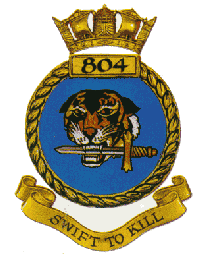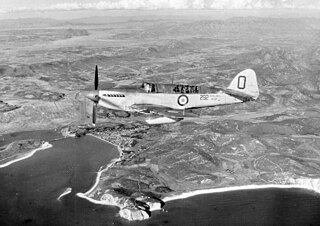Related Research Articles

The Fairey Seafox was a 1930s British reconnaissance floatplane designed and built by Fairey for the Fleet Air Arm. It was designed to be catapulted from the deck of a light cruiser and served in the Second World War. Of the 66 built, two were finished as landplanes.

700 Naval Air Squadron is an experimental test squadron in the Royal Navy’s Fleet Air Arm.

702 Naval Air Squadron was a naval squadron of the Royal Navy's Fleet Air Arm. It was based at RNAS Yeovilton in Somerset. As a training Squadron it trained all ground and air crew for the sister front-line maritime Lynx squadron, 815 NAS

815 Naval Air Squadron is a squadron of the Fleet Air Arm, part of the Royal Navy, based at RNAS Yeovilton in Somerset; it is the Navy's front line Wildcat Naval Air Squadron. It comprises AgustaWestland Wildcat HMA.2 helicopters and is the largest helicopter squadron in western Europe.

804 Naval Air Squadron was a Naval Air Squadron of the Royal Navy, formed in November 1939 from part of 769 NAS Sea Gladiators which had been detached to RNAS Hatston. The squadron was merged into 800 NAS in June 1944 and subsequently reformed in September.
701 Naval Air Squadron was a Royal Navy Fleet Air Arm squadron, formed on 24 May 1939, that saw service during the Second World War.
810 Naval Air Squadron was a Royal Navy Fleet Air Arm carrier based squadron formed on 3 April 1933 with the amalgamation of the 12 Blackburn Dart aircraft from 463 and 44 Flight Flights Royal Air Force to the Fleet Air Arm. The squadron saw action during the Second World War, the Suez Crisis and the Korean War.

814 Naval Air Squadron or 814 NAS, nicknamed the Flying Tigers, is a squadron of the Royal Navy Fleet Air Arm. It is currently equipped with the AgustaWestland Merlin HM2 anti-submarine warfare helicopter and is based at Royal Naval Air Station (RNAS) Culdrose in Cornwall. The squadron was formed in December 1938 and has been disbanded and reformed several times.

825 Naval Air Squadron is a Royal Navy Fleet Air Arm Naval Air Squadron which was re-commissioned on 10 October 2014 and currently flies the AgustaWestland Wildcat HMA.2.

703 Naval Air Squadron of the Fleet Air Arm of the Royal Navy was formed as a long-range catapult squadron on 3 March 1942 at RNAS Lee-on-Solent. During the Cold War, it was reformed as an experimental trials unit, and then as a helicopter training squadron. Since 2003, the squadron has formed the Royal Naval wing of the Defence Elementary Flying Training School at RAF Barkston Heath.

826 Naval Air Squadron was a Fleet Air Arm aircraft squadron formed during World War II which has been reformed several times since then until last disbanded in 1993.

737 Naval Air Squadron was a squadron of the Fleet Air Arm which operated Westland Wessex HAS.3 rescue helicopters from their land base at RNAS Portland, Dorset.

706 Naval Air Squadron was a Naval Air Squadron of the Royal Navy's Fleet Air Arm. Established as a fighter and torpedo-bomber training unit in Australia at the end of World War Two, it was briefly reformed as a helicopter squadron in the early 1950s, before becoming a helicopter training unit in 1962, and operating until 1998.
1791 Naval Air Squadron of the Fleet Air Arm of the Royal Navy was formed on 15 March 1945 at Lee-on-Solent as a night fighter squadron. It was equipped with the Fairey Firefly NF.Mk I, which was fitted with radar in a centre-line container. The squadron joined HMS Puncher in June for deck landing practice but saw no action. Following VJ day the squadron was disbanded on 23 September 1945 at RNAS Burscough.
710 Naval Air Squadron was a Naval Air Squadron of the Royal Navy's Fleet Air Arm. 710 NAS was a seaplane squadron that was stood up at RNAS Lee on Solent on 23 August 1939. They were equipped with the Supermarine Walrus flying boat and did multiple deployments onboard HMAS Albatross (1928), a seaplane tender. They performed convoy escort, anti submarine patrols, and air sea rescue services in the Atlantic off the west coast of Africa and in the Indian Ocean, in addition to support roles like pulling target drogues for gunnery practice and aerial photography. The squadron supported Allied landings during Battle of Madagascar in April and remained in the area through November. The squadron did some further work in the Indian Ocean but was eventually sent back to England where it was disbanded on 14 October 1943. The squadron was reformed on 7 October 1944 on the Isle of Man as a torpedo training squadron equipped with Fairey Barracuda and Fairey Swordfish torpedo bombers. The squadron was finally disbanded at HMS Urley[RNAS Ronaldsway] on 20 December 1945.

777 Naval Air Squadron was a Fleet Requirements Unit which was formed in West Africa during the Second World War.
1770 Naval Air Squadron was a Naval Air Squadron of the Royal Navy's Fleet Air Arm. It formed at RNAS Yeovilton on 10 September 1943 as a two-seat fighter squadron and embarked on HMS Indefatigable in May 1944. It took part in several attacks on the German Battleship Tirpitz and other operations in Norwegian waters before sailing for the Far East. In 1945, as part of the British Pacific Fleet, the squadron took part in attacks on Sumatra, Sakishima Gunto and Formosa. It disembarked to Australia in June 1945 and then disbanded on 30 September 1945 at RAAF Maryborough.
1820 Naval Air Squadron was a Naval Air Squadron of the Royal Navy's Fleet Air Arm. It formed at Brunswick (Maine) 1 April 1944 and embarked on HMS Arbiter in July. However its aircraft were judged unsatisfactory for their intended role and the squadron disbanded on 16 December 1944 at RNAS Burscough.
1831 Naval Air Squadron was a Naval Air Squadron of the Royal Navy's Fleet Air Arm.
References
- 1 2 Sturtivant & Ballance 1994 , p. 36
- ↑ Sturtivant & Ballance 1994 , pp. 15, 36
- Sturtivant, Ray; Ballance, Theo (1994). The Squadrons of the Fleet Air Arm. Tonbridge, Kent, UK: Air Britain (Historians) Ltd. ISBN 0-85130-223-8.
| This article about a specific British military unit is a stub. You can help Wikipedia by expanding it. |
| This United Kingdom navy-related article is a stub. You can help Wikipedia by expanding it. |
| This military aviation article is a stub. You can help Wikipedia by expanding it. |